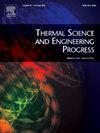Fluid flow and heat transfer in two-segmented microchannels within the slip flow regime
IF 5.4
3区 工程技术
Q2 ENERGY & FUELS
引用次数: 0
Abstract
We theoretically investigate gaseous slip flow and heat transfer in circular microchannels with two different wall materials in the lateral direction. The flow is considered as steady and fully-developed, and constant but different wall heat fluxes are assumed for the channel segments. While infinite series solutions are obtained for the velocity and temperature distributions as well as the Nusselt number, finite-element numerical simulations are also performed to confirm the validity of the analytical solutions developed. It is demonstrated that the average Nusselt number of the channel depends on several parameters comprising the Knudsen number, the Prandtl number and specific heat ratio of the gas, the momentum and thermal accommodation coefficients, and the angular span of either channel segment as well as the heat flux ratio of the two segments. It is further illustrated that the fluid velocity is strongly non-uniform in the angular direction when the channel segments have different momentum accommodation coefficients. This significantly affects the heat transfer rates, especially at high Knudsen numbers where the rarefaction effects are more significant. An inspection of the dimensionless average velocity variations shows that reducing the momentum accommodation coefficient of one channel segment while keeping that of the other one constant leads to higher average velocities, whereas the opposite is true for the influence of the thermal accommodation coefficient on the average Nusselt number. Finally, it is shown that the Nusselt number is a maximum for a symmetric wall heating.
滑移流动状态下两段微通道内的流体流动和传热
本文从理论上研究了两种不同壁材的圆形微通道的横向滑动流动和传热。流动被认为是稳定和充分发展的,并且假定通道段的壁面热通量恒定但不同。在得到速度和温度分布以及努塞尔数的无穷级数解的同时,还进行了有限元数值模拟以证实所开发的解析解的有效性。结果表明,通道的平均努塞尔数取决于气体的克努森数、普朗特数和比热比、动量和热容纳系数、通道段的角跨度以及两段的热流密度比等参数。进一步说明,当通道段的动量调节系数不同时,流体速度在角方向上具有强烈的不均匀性。这显著影响传热速率,特别是在高克努森数时,稀薄效应更为显著。对无量纲平均速度变化的检查表明,在保持另一通道段的动量调节系数不变的情况下,降低一通道段的动量调节系数会导致更高的平均速度,而热调节系数对平均努塞尔数的影响则相反。最后,证明了对称壁面加热的努塞尔数是一个最大值。
本文章由计算机程序翻译,如有差异,请以英文原文为准。
求助全文
约1分钟内获得全文
求助全文
来源期刊

Thermal Science and Engineering Progress
Chemical Engineering-Fluid Flow and Transfer Processes
CiteScore
7.20
自引率
10.40%
发文量
327
审稿时长
41 days
期刊介绍:
Thermal Science and Engineering Progress (TSEP) publishes original, high-quality research articles that span activities ranging from fundamental scientific research and discussion of the more controversial thermodynamic theories, to developments in thermal engineering that are in many instances examples of the way scientists and engineers are addressing the challenges facing a growing population – smart cities and global warming – maximising thermodynamic efficiencies and minimising all heat losses. It is intended that these will be of current relevance and interest to industry, academia and other practitioners. It is evident that many specialised journals in thermal and, to some extent, in fluid disciplines tend to focus on topics that can be classified as fundamental in nature, or are ‘applied’ and near-market. Thermal Science and Engineering Progress will bridge the gap between these two areas, allowing authors to make an easy choice, should they or a journal editor feel that their papers are ‘out of scope’ when considering other journals. The range of topics covered by Thermal Science and Engineering Progress addresses the rapid rate of development being made in thermal transfer processes as they affect traditional fields, and important growth in the topical research areas of aerospace, thermal biological and medical systems, electronics and nano-technologies, renewable energy systems, food production (including agriculture), and the need to minimise man-made thermal impacts on climate change. Review articles on appropriate topics for TSEP are encouraged, although until TSEP is fully established, these will be limited in number. Before submitting such articles, please contact one of the Editors, or a member of the Editorial Advisory Board with an outline of your proposal and your expertise in the area of your review.
 求助内容:
求助内容: 应助结果提醒方式:
应助结果提醒方式:


